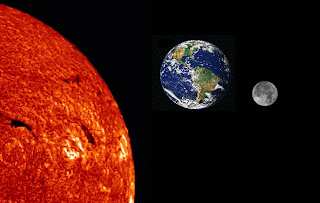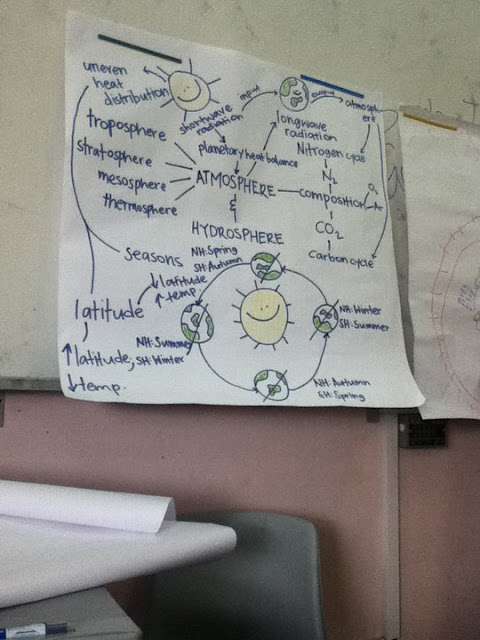What is Latitude?
- Latitude lines are horizontal lines running across the earth. They measure the distance of a location from the equator. Latitude is measured by the angle from the centre of the earth to the location you are measuring. That is why the equator is called 0 degrees.
Fig 1: Latitudes
Here is the trend of uneven heat distribution. Try superimposing the latitude lines onto the picture.
Fig 2: Uneven Heat Distribution
Here is a picture of the Earth and the Sun.
Fig 3: Earth and Sun
Clearly, something happens as the sun's rays hit the earth that causes some regions to be hotter than others. That process is best represented through shortwave and longwave radiation. As we know, shortwave radiation is absorbed by the atmosphere and the earth's surface. Some of it is reflected back into space. The radiation that is not reflected back, that is, the radiation that stays in the Earth's system, is converted into longwave radiation and circulates as heat in the Earth.Eventually, the system is completed when the same amount of heat that was added into the Earth by the sun is released into space by the Earth.
We know that areas where latitude is farther from the equator experience less heat from the sun. This is shown through a diagram in our booklet:
This then shows us that areas which are closer to the sun receive more shortwave radiation. As more shortwave radiation is then converted into longwave radiation in the atmosphere over that particular location, there is greater greenhouse effect. Greater input and output means greater heat running through the system at any one time. This contributes to high temperatures near the equator.
The absorption of the sun's shortwave radiation can be further broken down into its component parts. Areas near the equator that have high humidity, such as Singapore, absorb more shortwave radiation through clouds and aerosols (water vapour). There is also more conduction, convection and condensation going on as water rises into the Earth's atmosphere, which contributes to the units of energy released into the atmosphere as sensible heat and latent heat. All this adds up to greater greenhouse effect. This may be why we have higher temperatures than our neighbour Malaysia despite being around the same latitude. However, why does Singapore, which clearly absorbs a lot of shortwave radiation, have lower temperatures than some areas in Africa, even though they are much farther north of the Equator than us?
Turns out that climate is based on many more factors than latitude. Singapore is near the ocean, which acts as a heat sink. Our temperatures experience very little fluctuation because of the higher heat retaining properties of water. Water has higher heat capacity than land, thus when it is hot our land temperatures are lowered by the water. When it is colder our land temperatures are warmed by the water.
Also, the winds circulating around Singapore are primarily trade winds. The two trade winds from the northern and southern hemisphere meet at the equator (ie. where Singapore is.) When the winds meet, it causes the air to rise. As the air enters the higher end of the troposphere it condenses causing clouds and rain. Rain cools the surface, lowering temperatures. Clouds have a fairly strong albedo effect, reducing the radiation absorbed into the atmosphere.
Africa is a semi-arid country, with a great expanse of inland where there are no coastal areas to absorb the heat from the sun. The hottest countries in Africa are clustered around the Tropic of Cancer, roughly 23 degrees latitude, which t receives direct, concentrated sunlight for a quarter of a year. However, there are also areas in Africa near the sea where it is very, very hot. This can be explained via wind patterns.
Both westerlies and trade winds blow away from the 30 ° latitude belt. Over large areas centered at 30 ° latitude, surface winds are light. Air slowly descends to replace the air that blows away. Any moisture the air contains evaporates in the intense heat, thus it is very hot and dry. The tropical deserts, such as the Sahara of Africa, exist under these regions.
I also feel that because Africa has little clouds and aerosols, more radiation is absorbed directly at the surface as opposed to by clouds and aerosols. There is also absence of albedo effect that would reflect radiation back into space thus the land really gets the full extent of shortwave radiation. Thus in Africa, more heat is felt closer to the Earth's surface leading to high temperatures.
More info on Climates:
The Köppen system recognizes five major climate types based on the annual and monthly averages of temperature and precipitation. Each type is designated by a capital letter.
A - Moist Tropical Climates are known for their high temperatures year round and for their large amount of year round rain.
Clearly, this refers to Singapore.
B - Dry Climates are characterized by little rain and a huge daily temperature range. Two subgroups, S - semiarid or steppe, and W - arid or desert, are used within the Bclimates.
Deserts fall under this category. Africa is semi-arid as mentioned above. The Sahara desert is arid.
C - In Humid Middle Latitude Climates land/water differences play a large part. These climates have warm,dry summers and cool, wet winters.
Los Angeles in the US is on example.
D - Continental Climates can be found in the interior regions of large land masses. Total precipitation is not very high and seasonal temperatures vary widely.
Yakutsk, Russia is an example of this. The climograph can be found in our book.
E - Cold Climates describe this climate type perfectly. These climates are part of areas where permanent ice and tundra are always present. Only about four months of the year have above freezing temperatures.
Greenland, for example.
It's kind of interesting to see that we have such a huge variation of climates in the world. It truly creates much diversity of life.
N.B.
If you live north of the Tropic of Cancer or south of the Tropic of Capricorn, you do not receive direct sunlight at any point in the year. This explains the sudden drop in temperatures on the Earth's surface.
(Observe the sharp drop from orange to yellow with hardly any intermediate temperatures.)
Posted by: Lee Shu En
Sat 26 Feb












